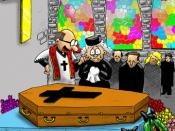Since the beginning of human history, death has been the most terrifying force and the greatest teacher that our species has had. Being notoriously difficult to understand, it seems inevitable that humans are afraid of it. Yet death has been an important teacher to every generation of man. Without death, men would have never conceived the idea of a separate body and soul. Without this distinction, it is quite possible that many of the religions and various Gods that make the world so culturally diverse would have never existed. The first thinking men were probably well aware that death is a fact of life, well aware that it is inescapable. Whenever their fellow hunter was killed during a hunt, it must have been painfully clear to them that although their companion's body remained intact, something had changed. Something that they could not see which caused their fellow man to respond--to breathe, to eat, and essentially be the person they had always known him or her to be--had left the body.
Thousands of years later, the confrontation and acceptance of death as a part of life is still a bridge that every person, no matter what culture they reside in, must cross. However, the cultural differences caused by the diverging paths of people through the ages have yielded many traditions about meeting, coping with, and finally accepting death. The histories of two cultures such as the Japanese and the Catholics of South America are a good example of how two different traditions work in different ways to confront the same basic human dilemma: the loss of the familiar form of a loved one and the transition between the physical and spiritual world. Although death and spiritualism are common to both Japanese and Latin American culture, the rituals and traditions surrounding death...


